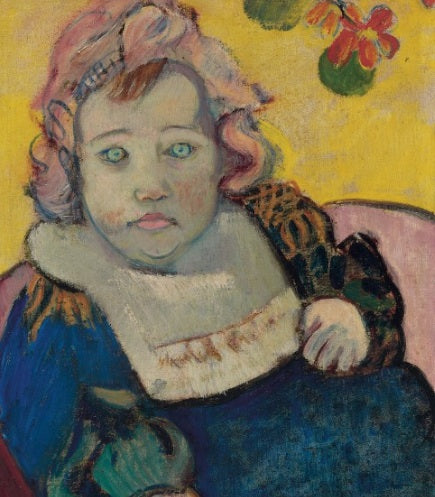Description
Paul Gauguin's painting "The Child" (1895) is a work that encapsulates both the artist's uniqueness and the complexity of the depiction of children in late 19th-century art. In this work, Gauguin displays his signature post-impressionist style, where the exploration of color and form intertwine to create a deeper meaning than is apparent at first glance. When looking at the painting, one notices the presence of a child sitting in a natural setting, a recurring theme in Gauguin's work that reflects the artist's fascination with the purity and innocence associated with childhood.
The figure of the child is placed at the centre of the composition, suggesting a particular attention to his being. This child, depicted with facial features that evoke a mixture of curiosity and tranquillity, seems to contemplate the world around him, devoid of the complications of adult life. His relaxed posture, with one leg crossed over the other, conveys a spontaneity that challenges the conventions of rigidity in the representation of children that was common in academic painting of the time.
Gauguin, a lover of colour and the simplification of forms, uses a vibrant palette that brings the scene to life. Yellow and green tones predominate in the context, suggesting an intimate connection between the child and his natural surroundings. Shadows and lights are treated with a technique that emphasises the two-dimensionality of the work, suggesting a pictorial space that moves away from the illusion of realism, which is characteristic of Gauguin's style. This use of colour not only provides an ornamental quality, but also underlines the emotionality of the scene, a search to capture the essence of childhood.
In terms of iconography, the painting contains no explicit narrative elements, inviting the viewer to a more introspective interpretation. The child, being alone in the composition, may represent the loneliness of childhood, a theme that Gauguin explored in several of his works. This loneliness becomes a point of connection that refers us to the existential search not only of the child in itself, but to a broader reflection on innocence and the transitions to adulthood.
Gauguin, who lived in Tahiti in the years following the creation of this work, sought inspiration in indigenous culture and symbolism, moving away from the European traditions that had dominated his artistic training. Although The Child was created before his trip to the Pacific Islands, it already reflected his interest in primitive themes and a simpler way of life. This connection with the primitive became a common thread in his later works, where he emphasized a return to the essential and to nature.
In conclusion, Paul Gauguin's "The Child" is more than just a depiction of childhood; it is a profound exploration of the human condition through the purity of childhood. The vivid colors, figure-centered composition, and emotionality inherent in the work are elements that evidence Gauguin's post-impressionist style and his intention to transcend the superficial. Through this work, the viewer is invited to reflect on his or her own relationship with childhood, innocence, and the inevitable passage of time, universal themes that resonate throughout art history.
KUADROS ©, a famous painting on your wall.
Hand-made oil painting reproductions, with the quality of professional artists and the distinctive seal of KUADROS ©.
Painting reproduction service with satisfaction guarantee. If you are not completely satisfied with the replica of your painting, we will refund 100% of your money.

